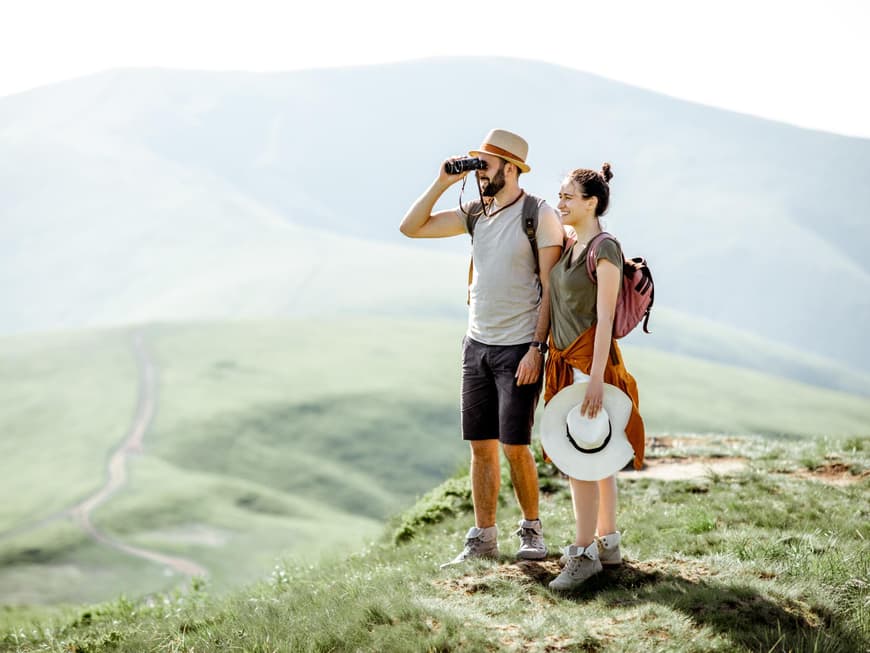
- Proper preparation for long hikes
- Consider duration, distance and altitude difference
- Find out about the climate, season and weather
- Essential equipment for hikes
- Suitable clothing: Hiking boots, rucksack & co
- Hydration system and food
- Navigation devices and maps
- Safety and first aid on long hikes
- First aid kit and rescue blanket
- Pocket knife or multitool
- Cell phone with emergency contacts and power bank
Proper preparation for long hikes
Careful planning is the key to a successful and safe hike. Before you set off, you should be aware of a few important points in order to be optimally prepared.
Consider duration, distance and altitude difference
The route length, duration and altitude difference are important factors when planning a hike. The longer the route and the more climbs you have to tackle, the more time you should allow and the lighter your pack should be. A realistic assessment of your own fitness level and experience will help you to choose the route accordingly.
Find out about the climate, season and weather
Weather conditions and the climate also play an important role when preparing for a hike. If you find out in advance about the expected temperatures, precipitation and wind conditions in the region, you are better protected against unpleasant surprises.
The next step is to put together the right equipment.
Essential equipment for hikes
The right equipment is crucial for a successful hike. In addition to suitable hiking boots and a functional hiking rucksack, a reliable hydration system and sufficient food and drink should not be missing. Navigation devices and maps ensure that you always stay on the right path.
Suitable clothing: Hiking boots, rucksack & co
Well-worn hiking boots are the be-all and end-all for any hike. Depending on the terrain and your personal preferences, you can choose robust hiking boots or mountain boots. Make sure they have a non-slip sole and provide sufficient support for your feet. The hiking rucksack should fit comfortably and have compression straps and an integrated rain cape. Good ventilation and an ergonomic carrying system increase comfort over long distances. It is also helpful to have additional clothing such as jackets and extra socks with you. A North Face jacket, for example, can protect you in the event of showers or storms.
Hydration system and food
Sufficient hydration is essential on hikes. A hydration system, such as a hydration bladder or water bottle, allows you to drink regularly without any hassle. Every hiking rucksack should also contain sufficient provisions and energy bars for the journey. Choose nutritious snacks that are light and durable.
Navigation devices and maps
Navigation devices and maps are essential for reaching your destination safely. A GPS device helps with orientation and reliably shows you the right route. Alternatively, topographical maps and a compass can also be used. A headlamp is also recommended to keep an overview in unforeseen situations or when it gets dark.
Safety and first aid on long hikes
Even with careful preparation, emergencies can occur along the way. It is therefore important to carry a basic first aid kit with you on long hikes.
First aid kit and rescue blanket
A compact first aid kit belongs in every hiking rucksack. It should contain plasters, wound dressings, elastic bandages, scissors, tweezers and a rescue blanket. The rescue blanket not only serves as protection against the cold, but can also be used for first aid treatment of injured persons.
Pocket knife or multitool
A pocket knife or multitool is versatile and can provide valuable services in emergency situations. It can be used to remove branches, cut ropes or carry out minor repairs. When buying, pay attention to quality and robustness so that the tool works reliably even under adverse conditions.
Cell phone with emergency contacts and power bank
A fully charged cell phone is essential to be able to call for help in an emergency. Store important emergency contacts such as mountain rescue, local emergency services and relatives in your cell phone. A power bank ensures that the device remains ready for use even on longer tours.
In addition to first aid equipment, it is advisable to acquire basic first aid skills. This will enable you to react quickly and correctly in an emergency and gain valuable time until professional helpers arrive.





